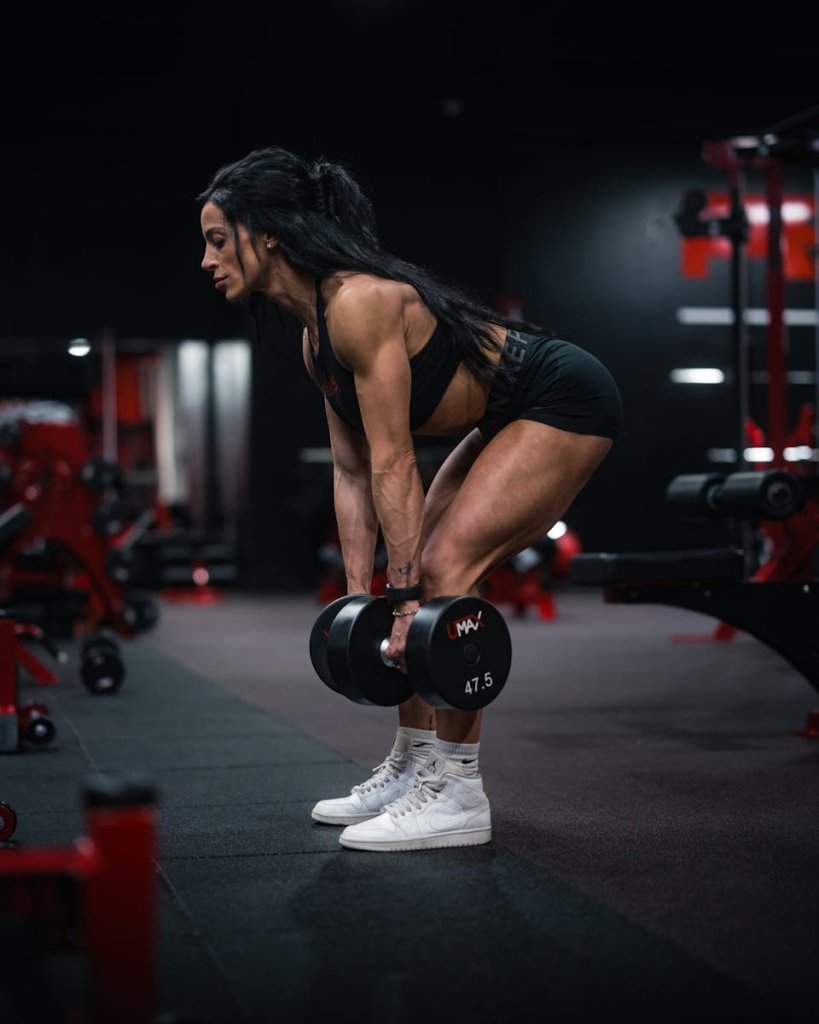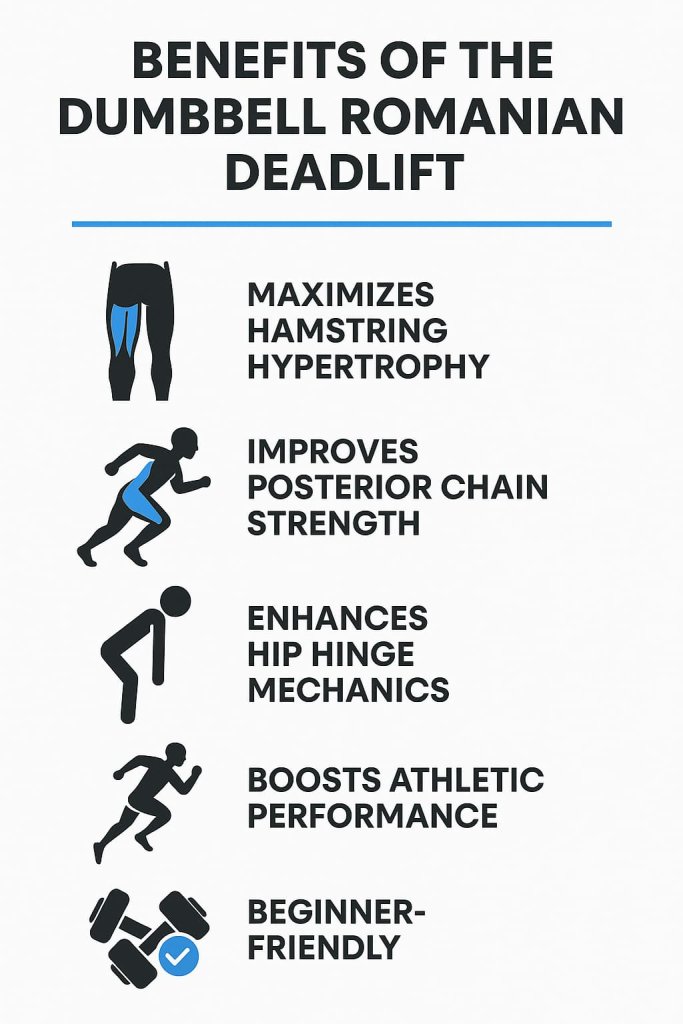The Dumbbell Romanian Deadlift (RDL) is one of the most effective exercises to target and build powerful hamstrings. It uses a controlled hip-hinge pattern to load the hamstrings and glutes, improving strength, flexibility, and injury resistance. Mastering this move will help you lift more, run faster, and move better in daily life.

Whether you’re training for aesthetics, sports performance, or functional strength, the Dumbbell RDL deserves a place in your program. With proper form, it enhances posterior chain strength, improves posture, and supports overall lower-body development.
What Is the Dumbbell Romanian Deadlift?
The Dumbbell RDL is a lower-body strength exercise performed with dumbbells held in front of the thighs. Unlike conventional deadlifts, the RDL starts from a standing position and emphasizes the eccentric (lowering) phase, creating a deep stretch in the hamstrings while keeping the knees slightly bent.
Primary muscles worked:
- Hamstrings
- Gluteus maximus
- Erector spinae (lower back)
- Core stabilizers
Secondary muscles:
- Forearms (grip strength)
- Upper back (traps and rhomboids)
How to Do the Dumbbell Romanian Deadlift (Step-by-Step)
- Start Position
- Stand with feet hip-width apart.
- Hold a dumbbell in each hand with a neutral grip, palms facing your thighs.
- Keep shoulders back, chest proud, and core braced.
- Hinge Movement
- Push your hips back as if closing a car door with your glutes.
- Maintain a slight bend in the knees (about 15–20°).
- Keep your back flat and spine neutral.
- Lower the Dumbbells
- Slide the dumbbells down your thighs and shins.
- Lower until you feel a strong stretch in your hamstrings — usually mid-shin height.
- Keep the weights close to your legs at all times.
- Return to Start
- Drive your hips forward while squeezing your glutes.
- Stand tall without leaning back or locking the knees.
Trainer Tip: Move slowly — especially on the way down — to maximize time under tension for muscle growth.
Benefits of the Dumbbell Romanian Deadlift

- Maximizes Hamstring Hypertrophy – Stretches the hamstrings under load, a proven stimulus for muscle growth.
- Improves Posterior Chain Strength – Builds the muscles responsible for sprinting, jumping, and explosive lifts.
- Enhances Hip Hinge Mechanics – Reinforces movement patterns needed for deadlifts, kettlebell swings, and Olympic lifts.
- Boosts Athletic Performance – Strong hamstrings reduce the risk of hamstring pulls and ACL injuries.
- Beginner-Friendly – Dumbbells allow lighter loads, more control, and easier learning compared to barbells.
Common Mistakes (and How to Fix Them)
| Mistake | Why It’s a Problem | Fix |
|---|---|---|
| Rounding the back | Increases risk of lower back injury | Brace core, keep chest up, hinge from hips |
| Knees locked out | Limits hamstring loading and strains joints | Maintain soft bend in knees |
| Weights drifting forward | Shifts load to lower back | Keep dumbbells close to legs |
| Rushing the movement | Reduces muscle activation | Use slow, controlled reps |
Programming Tips
- Goal: Hypertrophy – 3–4 sets of 8–12 reps
- Goal: Strength – 4–6 sets of 4–6 reps
- Rest – 60–90 seconds for hypertrophy, 2–3 minutes for strength
- Placement – Perform after squats or as the main posterior chain exercise.
Variations to Try
1. Single-Leg Dumbbell RDL
Why it Works:
This unilateral variation not only strengthens your hamstrings and glutes but also challenges your balance and coordination. Because each leg works independently, it helps fix strength imbalances and improves hip stability—important for sports and injury prevention.
How to Do It:
- Hold a dumbbell in one or both hands in front of your thighs.
- Stand tall with feet hip-width apart, then shift your weight onto one leg.
- Hinge at the hips, keeping your back flat, and extend the non-working leg straight behind you.
- Lower the dumbbells toward mid-shin height, keeping a slight bend in the standing knee.
- Drive your hips forward and return to standing.
Trainer Tip: Keep your hips square to the floor—avoid letting the lifted leg’s hip open up. Perform the same reps on each side.
2. Deficit Dumbbell RDL
Why it Works:
Standing on a small platform (2–4 inches) increases your range of motion, creating a deeper stretch for the hamstrings and glutes. This added depth promotes flexibility and mobility while boosting posterior chain strength.
How to Do It:
- Stand on a sturdy platform with feet shoulder-width apart.
- Hold dumbbells in front of your thighs, palms facing your legs.
- Hinge at the hips, lowering the dumbbells past mid-shin level for a full stretch.
- Maintain a slight bend in the knees and a neutral spine.
- Engage your hamstrings and glutes to return to the starting position.
Trainer Tip: Use lighter weight at first, as the extra depth can increase muscle tension and risk of overstretching if you lack mobility.
3. Banded Dumbbell RDL
Why it Works:
Attaching a resistance band to the dumbbells adds accommodating resistance—tension increases as you stand up, forcing your glutes and hamstrings to work harder at the top. This mimics athletic movements like sprinting, where force peaks during hip extension.
How to Do It:
- Anchor a resistance band under your feet, looping the ends around the dumbbell handles.
- Stand tall with the dumbbells in front of your thighs.
- Hinge at the hips, lowering until you feel a hamstring stretch.
- Drive your hips forward against the increasing band tension.
Trainer Tip: Focus on explosive hip drive while controlling the eccentric (lowering) phase for maximum benefit.
4. Tempo Dumbbell RDL
Why it Works:
Slowing down the lowering phase (eccentric) to 3–5 seconds increases time under tension, which stimulates greater muscle growth and improves hamstring strength. The slower pace also improves mind-muscle connection and form control.
How to Do It:
- Hold dumbbells at thigh level with feet hip-width apart.
- Hinge at the hips, lowering the dumbbells over 3–5 seconds.
- Pause briefly at the bottom for an extra stretch.
- Drive your hips forward to return to standing in 1–2 seconds.
Trainer Tip: Don’t rush—count the seconds out loud if needed to stay consistent. Keep your core braced throughout.
FAQs
1. Is the Dumbbell RDL safe for beginners?
Yes. Start light and focus on perfecting your hinge form before increasing weight.
2. Should the dumbbells touch the floor?
No. Stop when you feel a deep hamstring stretch — usually around mid-shin.
3. Can I replace barbell RDLs with dumbbells?
Yes, especially if you prefer more control or train at home.
4. How often should I do them?
1–2 times per week, depending on your split and recovery.
5. What’s the difference between RDL and stiff-leg deadlift?
RDLs use a slight knee bend and hinge from the hips; stiff-legs keep legs straighter.
Conclusion
The Dumbbell Romanian Deadlift is a powerful hamstring-builder that also strengthens the glutes, core, and lower back. By mastering the hip hinge and progressively increasing load, you’ll see noticeable gains in strength, muscle definition, and athletic performance.
